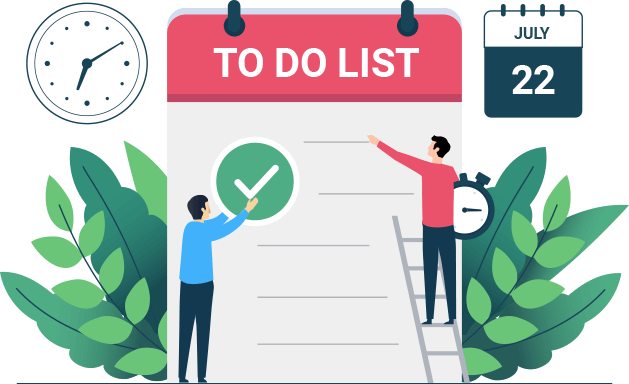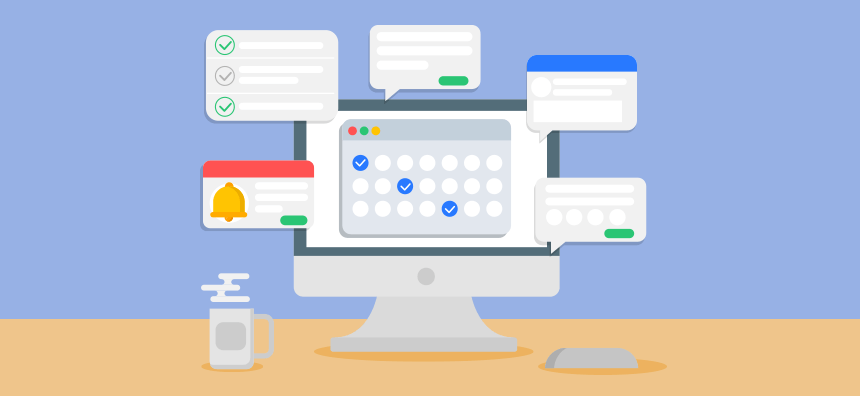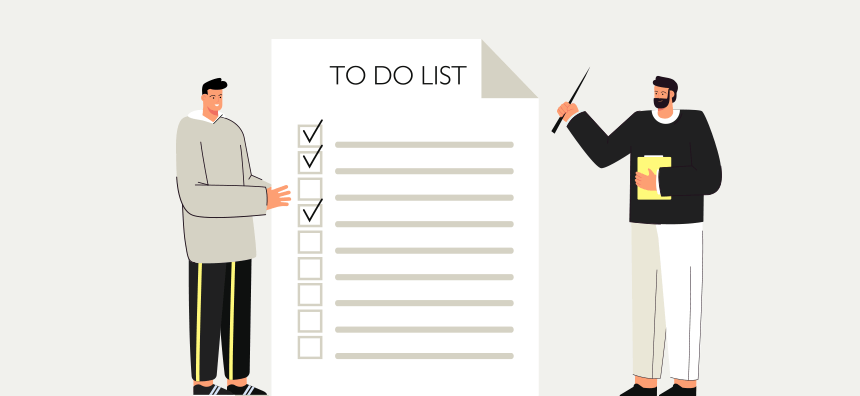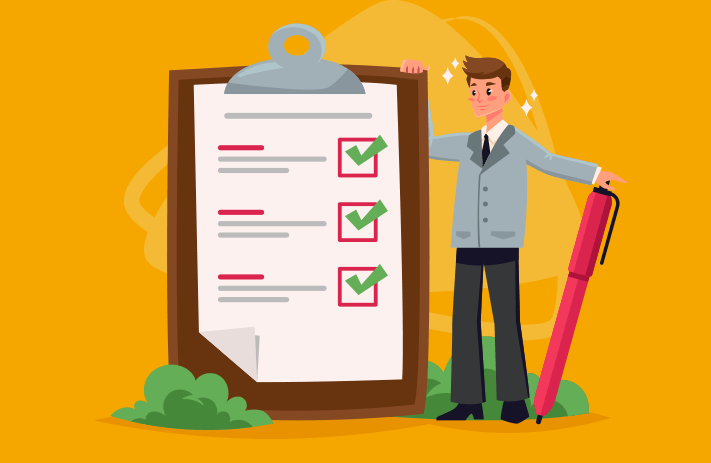
Click the button to start reading
Master Your To-Do List and Get Things Done
To-do or not to-do… that is the question!
But if you are reading this, you have decided that you need to do a to-do list.
The name describes its function: a to-do list is simply a list of tasks that you would like to accomplish. There are quite literally millions of templates designed to plug and play but having a deeper understanding of the psychology of to-do lists will ensure you are using this powerful tool to its full potential.
What is the Difference Between a To-Do List and a Checklist?
To-do list and checklist are terms that are often used interchangeably, but there are some very important distinctions to consider.
A to-do list is a specific list of tasks that you wish to accomplish in a set amount of time, usually daily but sometimes more long term.
A checklist is a to do list but it is specific to a repeatable process.
For example, maybe you are going camping this weekend. On your to-do list for the day, you will see “pack for camping trip”. The act of packing is a task that you wish to accomplish that day so it belongs on a to-do list. If camping is a regular activity for you, it is helpful to have a camping packing checklist. Though you have gone camping before, having a checklist will take the pressure off of our brain to remember what it was that you packed (or forgot to pack) last time.
You may think that you have done something enough times to not need a checklist but some of the brightest minds in the most complicated professions make use of checklists… and in some cases, it actually saves lives! Dr. Atul Gawande, author of The Checklist Manifesto and responsible for the Safe Surgery Initiative and Checklist, was able to reduce surgery related complications and deaths by over 35% with his simple yet effective checklist for surgery procedures. He found that simple steps were missed in preparation for procedures, even by the best of surgeons. Having a consistent and standard checklist took the pressure off of an already intense process by having a simple 19 point one page checklist to refer to.
Okay, so you may not be performing life saving surgery but if some of the smartest minds make use of this simple system, it is safe to say that implementing it in your own life will also have a positive impact.

Creating Effective Checklists
Greg McKeown, author of Effortless: Make It Easier to do What Matters Most, has a simple 4 item list to consider when creating your checklists:
- Observe your process
- Record your process
- Refine your process
- Teach your process to others
Greg is a big fan of actually recording yourself during the process and note what could be done better. Recording yourself may help you find efficiencies in your own process. Teaching others your process is a great way to retain the information and may even help someone else be more productive. In completing these steps, you are effectively creating a template checklist that can be reused by yourself or others.
Consider your everyday tasks and note what repeatable processes would benefit from a checklist.

Your Brain Likes To-Do Lists
The human brain is plastic, meaning that it is capable of changing as we take in new information or form new habits.
Think about it, we can literally change how our brains are wired by implementing helpful systems. Once we form a habit, it becomes automatic which is actually a great way to conserve our brainpower for more complicated tasks.
Your brain is a big fan of to-do lists. When you write down your to-dos, it gives permission to your brain to let them go. We tend to use our brain as this short term storage unit when that isn’t how it works and is not optimal for your productivity or energy.
Jot it down, your brain will thank you.
The Brain Dump
A clear brain is a happy brain.
Before you even think about drafting to-do lists, you need to perform a brain dump. A brain dump, like to-do lists, is pretty self explanatory: take what is taking up space in your brain and dump it onto a page or digital document.
Every. Single. Thing.
The first time that you do this, you may feel a bit overwhelmed. Chances are that you have been relying heavily on your brain to store unfinished tasks or ideas and have quite the backlog. Fortunately, you will start to feel lighter as you pour everything on to the page.
Have you ever wondered why unfinished tasks tend to take up so much space in our heads? Why do they pop up at the most inconvenient times? Russian psychologist Bulma Zeigarnik called this phenomenon the Zeigarnik effect. He suggests that unfinished tasks create cognitive tension and your brain keeps bringing it forward in an attempt to keep it in our short term memory so as not to forget it.
The magic of a brain dump is that you can get these tasks and ideas out of your head and to a safe place so your brain doesn’t feel the need to constantly remind you. Letting your brain rest will keep it energized for more demanding and important tasks.
Try scheduling a regular time for brain dumps. While once a week would be great, but even once a month would make a big difference in how you feel. Try doing a brain dump at the end of the week and you may find that you spend less time on your weekends ruminating about unfinished work to-dos.

To-Do List for Mental Health
Creating to-do lists can keep you on task but they also have surprising mental health benefits.
Most people today will describe feeling overwhelmed or stressed which is an unfortunate reality of our hustle culture. While the pandemic certainly has people rethinking work and life balance, most people are still left with heavy workloads and conflicting priorities.
Not only will writing down your daily tasks help to keep you organized, there is a real reward when you check off an item on your list – it is called dopamine. Dopamine is the “happy” hormone and we feel it because that checked off item represents an accomplishment – big or small. Even if a task can be done quickly, take a minute to add it to your to do list if only just to check it off because that small dopamine hit may just carry you through to the next task and the one after that.
While it is important to keep your professional work out of the space that you sleep in, having a notepad beside your bed to jot down to-dos will get them out of your head and actually help you to sleep better. The Zeigarnik effect is a notorious disrupter of sleep and the last thing you should be thinking about at the end of the day is unfinished or pending tasks. With practice, you will be able to jot these to-dos down at the end of your workday instead of before you go to bed. Knowing that there is a place for these thoughts, should they creep into your head, provides you with a sense of comfort knowing you won’t fall asleep to the tune of pending to-dos.
Feeling as though you are productive and are contributing to something outside of yourself is a cornerstone of mental health and to-do lists can help you accomplish that. There are times in our day where we have some unexpected time on our hands – Clients cancel, flights are late, or any number of unexpected things come up that give us unaccounted for blocks of time in your day. When you have a to-do list handy, you will likely be able to move to another task. You will feel productive which is a great boost to your overall mental health.

Types of To-Do Lists
Generally speaking, there are two main types of to-do lists – short and long term. Before dissecting the different types, it is important to understand how to be SMART with any type of list.
SMART To-Do Lists
Every task on your short or long term to-do list should be SMART – Specific, Measurable, Attainable, Realistic, and Time Bound.
Specific
It is tempting to have less items on your list and be more vague in their descriptions. You may decide to write down “prepare for team meeting” as an item on your list but being more specific will be more helpful in managing your time and keeping you on track. Ask yourself what exactly is needed to prepare for this meeting:
- Is there any preliminary research to be done?
- Do you need to draft an agenda?
- Are there minutes from a previous meeting to review?
- Do you need to prepare a visual presentation?
- Have they been sent a reminder?
- Is there any documentation you will need to print?
The one task of preparing for a client meeting was easily broken down into 6 possible SMART tasks. While this may add more items to your list, they are more specific and will help ensure that you are fully prepared and don’t miss anything.
Measurable
When it comes to ensuring that a task is measurable, you need to consider what it will look like when it is complete. If you have a task on your list to clear your inbox, a measurable indicator of the task being completed would be an empty inbox. Another task may be to find a better deal on a company cell phone or internet plan. The measure involved in that task’s completion would be a reduced phone or internet bill.
Oftentimes, measurement isn’t a specific number but more about the status of the outcome. If your theoretical client meeting ends with a happy customer, your measurement would be in terms of satisfaction.
Attainable
Be real, do you think you can actually finish your end of year report in one day with 20 other items on your to-do list? Likely not.
Refer back to the first item in the SMART acronym, specific. Break a task down in a way that is designed to set you up for success and be reasonable with the time and energy that will be required of you to complete it.
Perhaps completing an end of year report isn’t attainable in a single day, the best you can manage is the outline of the report or the collection of supporting materials. That is okay! When you set attainable to-dos, you are setting yourself up for success (and a nice dopamine hit).
Relevant
Is the task on your list relevant to your end goal? The answer to this question can depend on how you manage and categorize your lists. It is helpful to have several lists to lump relevant tasks together but also to ensure that you have goals that those tasks will combine to reach. Grouping tasks together will also help you maintain focus. Jumping from client meeting presentation to end of year report will cost you time in the switch so it may be more efficient to dedicate your morning to writing related activities and afternoon to meetings, lumping the relevant tasks together.
If you have a list in front of you, it may be helpful to actually write the goal at the beginning of the list. Ask yourself if you check off every item, will you be steps closer to that goal? If you are writing an end of year report, every task on that list should take you one step closer to completing that specific and measurable goal.
Time-bound
Deadlines are essential. You can run with the assumption that the items on your to-do list are due by the end of the day which works for some, but certain tasks will have deadlines that exist within the run of the day and should be noted. Noting deadlines will help you prioritize your daily activities, taking the guesswork out of the flow for your day.

Short Term To-Do Lists
Short term to-do lists are more familiar and include those that you would use for daily tasks. These often look like a notepad with checkboxes on your desk, a magnet pad on your fridge, or a list written on a whiteboard. These items are generally one time items like those specific to a particular task such as preparing for a work presentation. To-do lists are also often used for household chores and maintenance.
A work to-do list may look something like this:
- Check voicemail
- Send email to client regarding the status of the venue
- Choose a template for the end of year presentation
- Send in lunch order before 11:00am
- Draft agenda for team meeting
A personal to-do list may look something like this:
- Drop cupcakes off at the school before 9:00am
- Fill up gas tank
- Pick up part for the lawnmower
- Clean cat litter
- Wash bedding
While there are endless possibilities when it comes to individual lists, these examples all clearly demonstrate a specific task that can be done in a regular day. When a time isn’t specified or the task is non-time specific, it is safe to assume that the task simply needs to be accomplished at some point during the day. The cat litter can be changed anytime but the cupcakes need to be dropped off before the class party.

Long Term
Anything that cannot be completed in a day is considered an item to add to your long term to-do list. If you go to the next metric, it would make sense that you may also make use of weekly or even monthly to do lists. While not as detailed, these lists provide a bigger picture or an overview of the period of time and can be referenced in order to develop effective daily lists. For example, your weekly to-do list may note certain reports or presentations that are due. This list can be used to develop more specific items to be done in the course of a day to make the larger task more manageable.
Another example could be a larger project such as reaching a certain sales goal by the end of the year. This one item could live on your long term to-do list and be further broken down by goals for the month and weekly actions that will help get you there such as running a promotion or drafting a plan.
When you consider the utility of long term to-do lists. It is easy to see how long term to-do lists can be helpful for breaking down daily tasks to help you reach your goals.
Master To-Do List
While it does fall in the category of long term to-do lists, it is worth specifically mentioning the master to-do list…The to-do list of all to-do lists.
Think of a master to-do list as an organized brain dump, a place where you can add any tasks for both short and long term lists. If you have done your brain dump properly, you should end up with a number of items, some of which have nothing to do with each other all in one place. It is helpful to use a digital document so that you may easily copy and paste, grouping similar tasks and breaking down larger ones.
With everything in one place, you can pull from your master to-do list and add to your daily, weekly, or even monthly lists. Some items may remain on your master to-do list for a while and that is okay, you can get to them when they become a priority and they will be safely stored and out of your head in the meantime.

Creating Templates to Increase Productivity
We often find ourselves doing the same or similar tasks over and over again in our professional and personal lives. If this is the case for you, it may be helpful to create some templates that you can use to save time and energy.
If you travel regularly, it would be helpful to create a checklist of the items that you know you will need. Even if you have traveled dozens of times, having a list will ensure that you haven’t forgotten anything and take the load off your brain from having to dig around and find information from your past. Remember, even surgeons do it.
Another handy use of templates would be for work. If you work for an organization that plans events, it would be helpful to have checklists for pre and post event planning. Given that the event planning process looks similar each time, you can look professional and be prepared at the same time.
Invest some time to create templates that will save you time in the long run.

To-Do Tips
Big or small, short term or long term, to-do lists can help you reach your goals.
What do you wish to have accomplished at the end of the day? Perhaps you have a report that is due, a meeting with a client, or graphics to design for a new webpage. In an ideal world, you can picture the end of your day having accomplished the tasks specific to your goal.
But it isn’t enough to simply write “complete report” on your list. Depending on the type of report, you may have some research to do, some feedback to collect, or even need to design a template that can be used for future reports.
Bring it all back to your goal and the specific actions you need to do to accomplish it. Here are some final tips to ensure that your to-do lists are as effective as possible:
- Be SMART – Make sure that every item on your list is Specific, Measurable, Attainable, Realistic, and Time Bound.
- Prioritize – When did “priority” become “priorities”? Having multiple priorities simply waters down the importance and significance of having a single one. That does not mean that you only ever have to-do lists with only one item but it does mean that you understand that you have an order to the tasks that you wish to accomplish.
- Pick a Medium – While some people can manage both digital and physical lists it is best to pick one and stick with it.
- Use Categories – Keeping your to-dos organized by using categories will help keep you focused on the task at hand. It isn’t enough to breakdown work and personal, having categories within these lists will benefit you.
- Schedule Prep Time – Your to-do lists are not going to make themselves, put some time and consideration into drafting them and ensure they align with your goals of the day.
To-do lists are an incredibly helpful tool that you can use to stay focused and boost your productivity. Plan a brain dump, create a master to-do list, and start organizing your tasks in a way that will serve you.
















